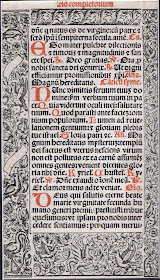Today I share with you a woodcut from my own [small] collection of relief prints. I bought this piece about fifteen years ago in a small shop in Boston's Beacon Hill, where it was labelled simply as "17th c woodcut." You can see, obviously, that it's a page from a book. My Vulgate Latin is not exactly fluent, but I can make out the "Nunc dimittis" and some "Kyriel"s. A little googling reveals that I've also got the hymn "Loving Mother of our Savior." So I believe that what I have here is a page from the compline section of a breviary or book of hours. Without taking it to an expert, I don't know its date any more exactly, nor its country of origin.
This is no medieval illuminated manuscript - I imagine that it's not a particularly high-end production - but I think it's attractive in its own right. I particularly like the wonderfully detailed border, with its plants and animals. There's a marvelous rabbit at the lower right, a nice selection of birds, and the very odd wyvern with a face in its chest in the center of the bottom. Many of the plants are detailed enough to be distinctly identifiable: strawberries, rose, columbine, violas… I think they're absolutely lovely.
Another thing I find really interesting about this piece is its construction. If you look closely, you can see that each border is printed from a separate strip of wood.
 The reverse of the page is printed with four more separate borders. I don't know how many different borders there were, but I imagine that throughout the entire book borders were reused in various combinations to make each page look unique without having to design an entirely new border. As for the text, I am not an expert to be able to recognize whether it was printed with a wood block or movable metal type, although I assume the latter. Certainly you can see the offsetting where the page was printed a second time with the red ink.
The reverse of the page is printed with four more separate borders. I don't know how many different borders there were, but I imagine that throughout the entire book borders were reused in various combinations to make each page look unique without having to design an entirely new border. As for the text, I am not an expert to be able to recognize whether it was printed with a wood block or movable metal type, although I assume the latter. Certainly you can see the offsetting where the page was printed a second time with the red ink.
 The reverse of the page is printed with four more separate borders. I don't know how many different borders there were, but I imagine that throughout the entire book borders were reused in various combinations to make each page look unique without having to design an entirely new border. As for the text, I am not an expert to be able to recognize whether it was printed with a wood block or movable metal type, although I assume the latter. Certainly you can see the offsetting where the page was printed a second time with the red ink.
The reverse of the page is printed with four more separate borders. I don't know how many different borders there were, but I imagine that throughout the entire book borders were reused in various combinations to make each page look unique without having to design an entirely new border. As for the text, I am not an expert to be able to recognize whether it was printed with a wood block or movable metal type, although I assume the latter. Certainly you can see the offsetting where the page was printed a second time with the red ink.
All in all, I love both the graphic look of the text and the contrast with the organic forms of the border. I find this small piece very pleasing - I might even say calming and contemplative, which is entirely appropriate for the office of compline.
[Pictures: Compline page from book of hours, woodcut, 17th century (two sides of the page).]


No comments:
Post a Comment
I love to hear from you, but please no spam, ads, hateful language, or other abuse of this community.